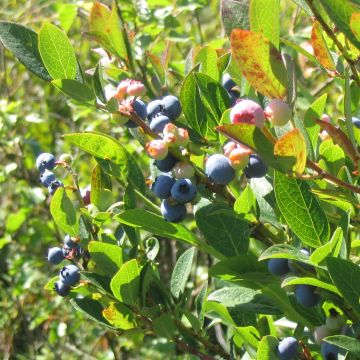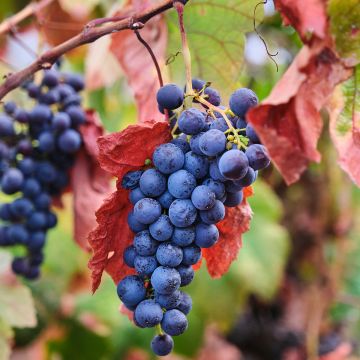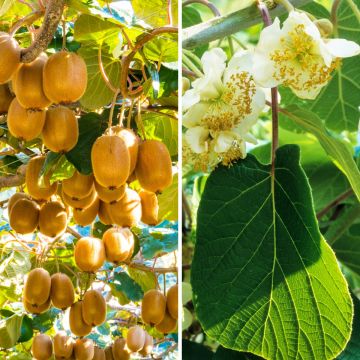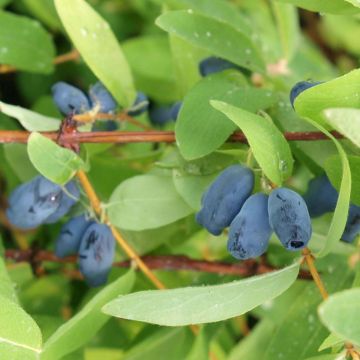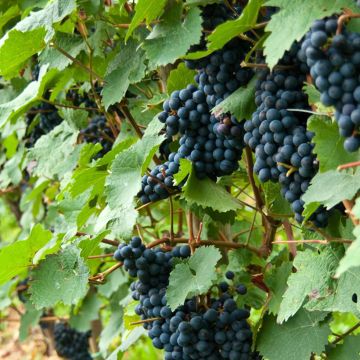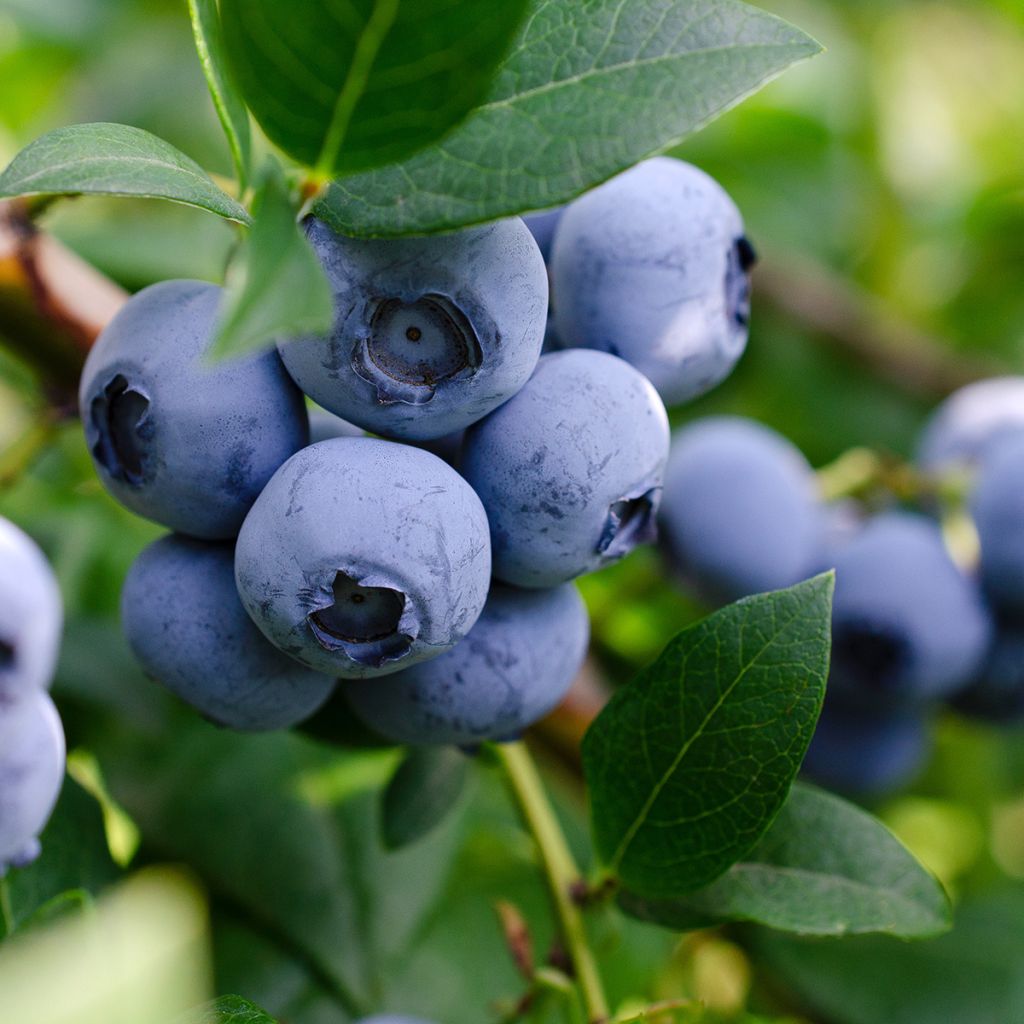

Vaccinium corymbosum Lucky Berry
Vaccinium corymbosum Lucky Berry
Vaccinium corymbosum Lucky Berry ®
American Blueberry, Highbush Blueberry, Swamp Blueberry, Tall Huckleberry
This item cannot be shipped to the selected country
Delivery charge from €5.90
More information
Delivery charge from €5.90
More information
Schedule delivery date,
and select date in basket
This plant carries a 6 months recovery warranty
More information
We guarantee the quality of our plants for a full growing cycle, and will replace at our expense any plant that fails to recover under normal climatic and planting conditions.
From €5.90 for pickup delivery and €6.90 for home delivery
Express home delivery from €8.90.

Description
The Vaccinium corymbosum 'Lucky Berry' is a variety with a dwarf and compact habit, capable of producing delicious fruits consistently for 4 months, from July to October. Due to its small size, not exceeding 0.80 to 1 m (3ft), this fruit bush adapts to many uses in the garden. The highly decorative flowering occurs from June to September. It consists of pretty white flowers that attract pollinating insects. To balance or adapt the plant to its space, pruning can be done to the desired height, in late winter. Very resistant to cold, it requires little maintenance and thrives in a fairly acidic and humus-bearing soil, preferably in the shade. Self-fertile, a single plant is sufficient to obtain a bountiful harvest, but a few other blueberry varieties can be planted nearby for an even more abundant fruiting.
The Blueberry, in Latin Vaccinium corymbosum, belongs to the Ericaceae family, just like Cranberries, heathers, and rhododendrons. The blueberry, also known as Highbush Blueberry or American Blueberry, is native to North America, where it grows naturally in acidic, moist, sandy, or peaty soils, along lakes and watercourses, in heathlands, undergrowth, and meadows in mountainous regions, up to 1600 m (5249ft) altitude. This species is cultivated in Europe, in a large number of cultivars selected for the quality and quantity of their fruits. Extremely cold-hardy (down to -30°C (-22°F)), this deciduous shrub, which loses its leaves in autumn, cannot tolerate limestone at all and needs to be grown in a very acidic soil (pH 4 to 5.5).
The Vaccinium corymbosum ‘Lucky Berry’ is part of a highly innovative range of fruit plants distributed under the Lucky Berry brand. It complements a range consisting of a blackberry, a strawberry, a raspberry, and a fig tree. All have been selected for their long harvest periods with high yields, sweet and juicy fruits, on compact vegetation suitable for container cultivation, while also being resistant to winter and diseases. This blueberry variety forms a bushy shrub with a very compact habit, reaching a height of 80 cm (32in) with a spread of 60 to 80 cm (24 to 32in). Like most Blueberries, its growth is relatively slow. The foliage consists of medium green elliptical and pointed leaves, measuring 6 to 7 cm (2 to 3in) long and about 3 cm (1in) wide. As an additional attraction, the branches take on beautiful autumnal colours in shades of red. The flowering occurs almost continuously, from late May to mid-September. The flowers appear in the form of small white bells, 0.5 to 1 cm (<1in) long, grouped in pendulous clusters 2 to 5 cm (1 to 2in) long, at the ends of the stems. They are attractive to bees and pollinating insects in the garden. This is followed by the formation of numerous clusters composed of elongated fruits shaped like teardrops, 10 to 13 mm (0 to 1in) long, bluish-purple in color and covered with a slight whitish bloom. The berries contain firm and juicy white pulp, containing the seeds.
Blueberry picking starts from July and continues until October, offering the advantage of staggered harvesting for many culinary delights. Blueberries should be picked when fully ripe, when they are dark blue-black, they are then sweet and tangy, juicy and flavourful. It is a delicate fruit that must be carefully picked, a light water rinse is possible. They keep better in the refrigerator. Picking is easy and it is very enjoyable to either enjoy the fruits on the spot or pick them for various culinary uses: jellies, jams, sorbets, coulis, syrups, juices, liqueurs, crumbles, muffins ... not to mention the famous blueberry pies. Low in calories, but rich in minerals (manganese, potassium, magnesium, iron), vitamins C and K, fibre, and antioxidants, blueberries contribute to a balanced diet.
Hardy down to -30°C (-22°F), the 'Lucky Berry' Blueberry thrives in slightly to very acidic soil, with a preference for fertile, well-drained, and moist soils, especially without limestone. Once established, it quickly forms a magnificent ornamental plant for your garden. This low-growing variety can easily be grown in containers, making it perfect for balconies and terraces, in a patio or a city garden. In the ground, it can be associated with other fruit trees to create a small edible hedge, but always avoiding overly sunny exposures. In this hedge, it can intertwine with the Mayberry (Lonicera kamchatka), raspberries, blueberries, blackberries, currants, or blackcurrants. These plants are vigorous and undemanding, making them perfectly suited for a natural garden. In an ornamental garden, the Lucky Berry blueberry will blend beautifully with ericaceous shrubs, bringing the colouration of its foliage, the intensity and duration of its flowering and fruiting.
Vaccinium corymbosum Lucky Berry in pictures
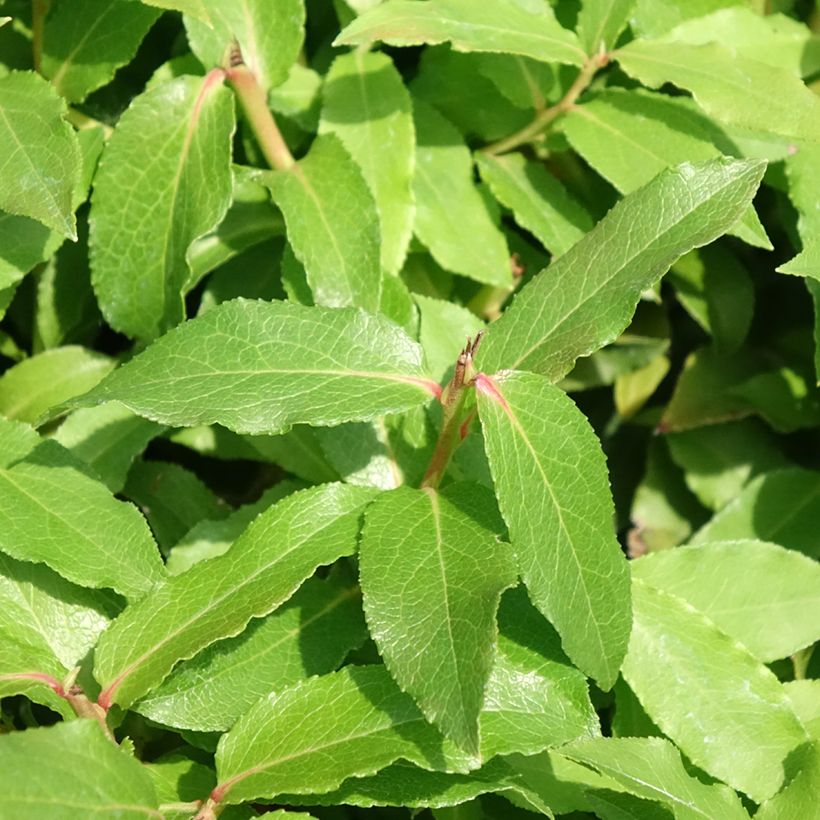

Plant habit
Fruit
Flowering
Foliage
Botanical data
Vaccinium
corymbosum
Lucky Berry ®
Ericaceae
American Blueberry, Highbush Blueberry, Swamp Blueberry, Tall Huckleberry
Cultivar or hybrid
Other Blueberry bush
Planting and care
The planting of the Blueberry Bush is ideally done in autumn or throughout the year, except during freezing and heatwave periods. This bush is planted in partial shade, on the edge of a wood, in a clear underwood, or in an east-facing position, without scorching sun. It is very hardy (-30°C (-22°F) for the plant but -5°C (23°F) for the flowers) and will grow without difficulty if the soil and exposure suit it. If you plant multiple plants, space them 0.80m (3ft) apart in all directions.
Plant it in a very acidic to acidic soil (pH between 4 and 6), incorporating pure heather soil or in a mixture of regular soil and turf, well-decomposed bark compost. The collar should be level with the ground. Firmly pack and water generously with non-limestone water. In slightly limestone to neutral soil, dig a hole 50 to 60cm (20 to 24in) deep, line the edges with a garden felt, then fill with a mixture of compost and heather soil. The bilberry tolerates soils occasionally saturated with water, for example, on the banks of water points.
The soil should remain consistently moist. If watering is necessary, use non-limestone and non-chlorinated water (e.g. rainwater collection). Mulch the base with shredded bark, straw, or fern leaves. It is sometimes useful to place a protective net if birds become too greedy during harvest. In spring, annually apply some well-rotted compost on the surface. The bilberry is a bush that is not very susceptible to diseases and pests.
For Container Cultivation: use a mixture of heather soil and potting soil, creating a drainage layer at the bottom of the perforated pot. Feed your blueberry bush with compost or fertiliser for small fruits and water regularly to keep the substrate always slightly moist but not waterlogged.
Planting period
Intended location
Care
Berries
Haven't found what you were looking for?
Hardiness is the lowest winter temperature a plant can endure without suffering serious damage or even dying. However, hardiness is affected by location (a sheltered area, such as a patio), protection (winter cover) and soil type (hardiness is improved by well-drained soil).

Photo Sharing Terms & Conditions
In order to encourage gardeners to interact and share their experiences, Promesse de fleurs offers various media enabling content to be uploaded onto its Site - in particular via the ‘Photo sharing’ module.
The User agrees to refrain from:
- Posting any content that is illegal, prejudicial, insulting, racist, inciteful to hatred, revisionist, contrary to public decency, that infringes on privacy or on the privacy rights of third parties, in particular the publicity rights of persons and goods, intellectual property rights, or the right to privacy.
- Submitting content on behalf of a third party;
- Impersonate the identity of a third party and/or publish any personal information about a third party;
In general, the User undertakes to refrain from any unethical behaviour.
All Content (in particular text, comments, files, images, photos, videos, creative works, etc.), which may be subject to property or intellectual property rights, image or other private rights, shall remain the property of the User, subject to the limited rights granted by the terms of the licence granted by Promesse de fleurs as stated below. Users are at liberty to publish or not to publish such Content on the Site, notably via the ‘Photo Sharing’ facility, and accept that this Content shall be made public and freely accessible, notably on the Internet.
Users further acknowledge, undertake to have ,and guarantee that they hold all necessary rights and permissions to publish such material on the Site, in particular with regard to the legislation in force pertaining to any privacy, property, intellectual property, image, or contractual rights, or rights of any other nature. By publishing such Content on the Site, Users acknowledge accepting full liability as publishers of the Content within the meaning of the law, and grant Promesse de fleurs, free of charge, an inclusive, worldwide licence for the said Content for the entire duration of its publication, including all reproduction, representation, up/downloading, displaying, performing, transmission, and storage rights.
Users also grant permission for their name to be linked to the Content and accept that this link may not always be made available.
By engaging in posting material, Users consent to their Content becoming automatically accessible on the Internet, in particular on other sites and/or blogs and/or web pages of the Promesse de fleurs site, including in particular social pages and the Promesse de fleurs catalogue.
Users may secure the removal of entrusted content free of charge by issuing a simple request via our contact form.




































